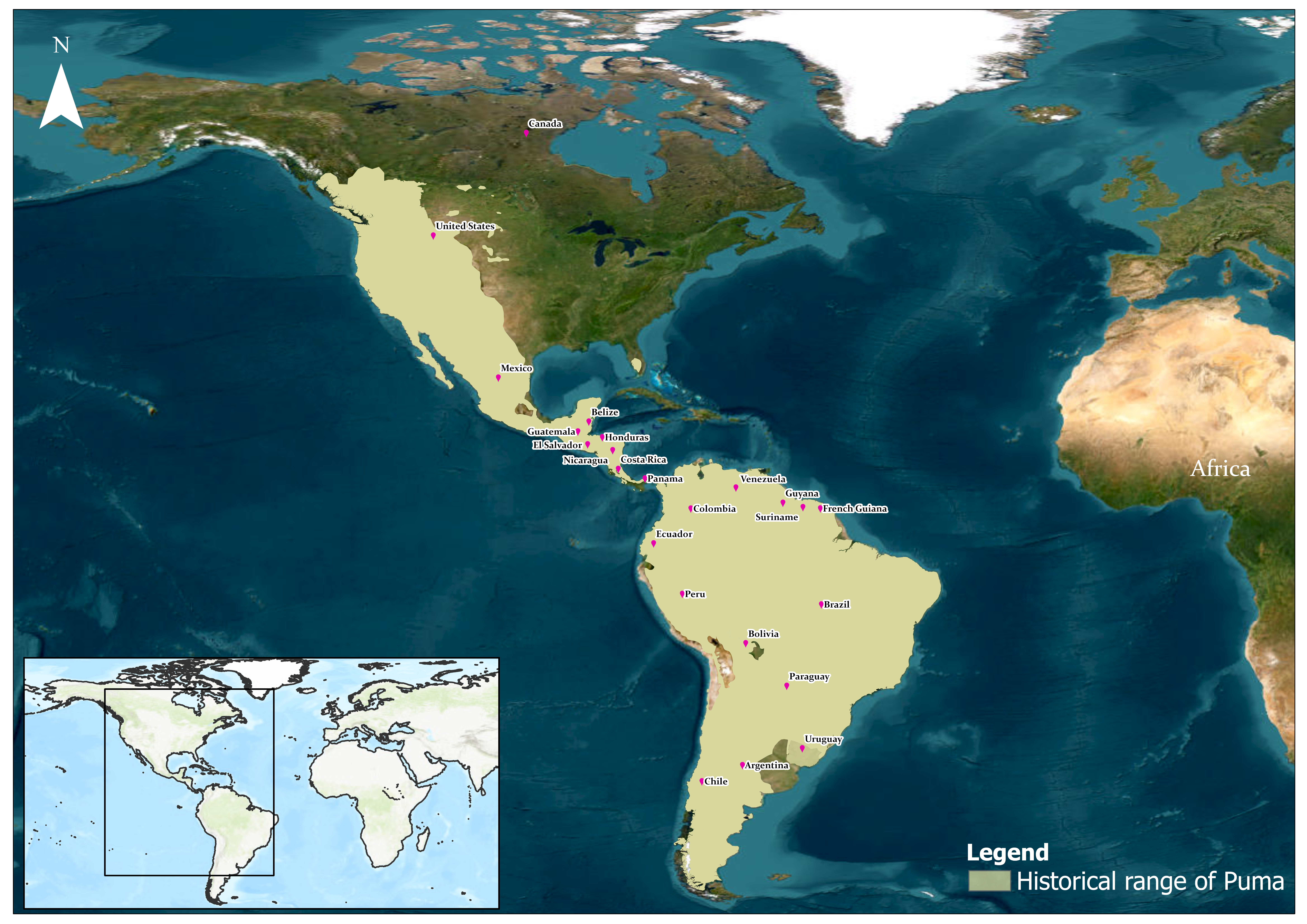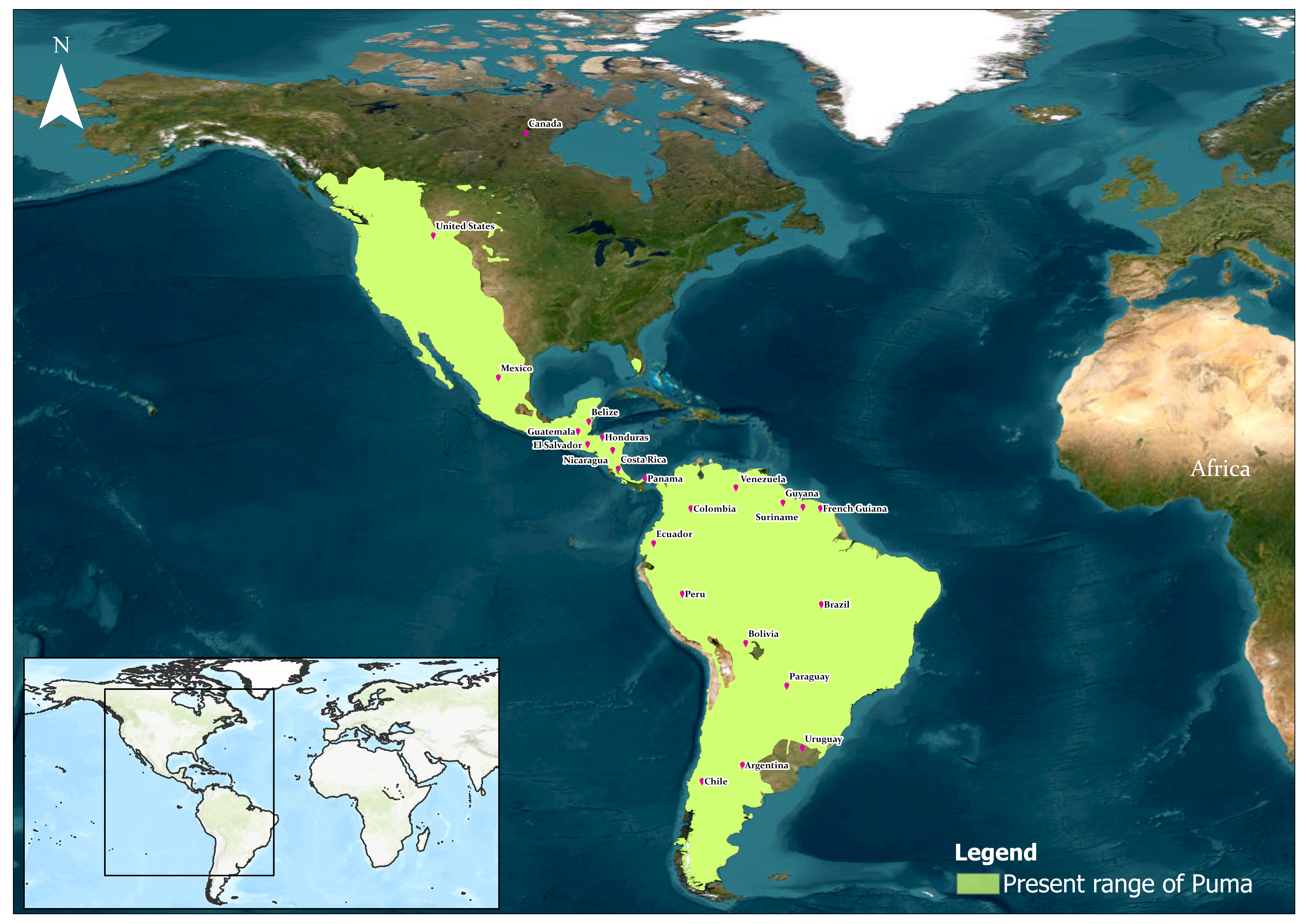Puma
Phylum: Chordata
Class: Mammalia
Order: Carnivora
Family: Felidae
Genus and species: Puma concolor
The puma, also known as the cougar or mountain lion, is a large cat species with the widest distribution of any New World mammal, spanning from southeastern Alaska to the southern tip of Chile. This remarkable range makes it one of the most widespread terrestrial mammals in the Western Hemisphere.
 (1).jpg)
Although the puma is a large animal, it is believed to be more closely related to small cat species because it lacks the elastic hyoid and enlarged vocal folds of the Pantherines. The puma’s long spinal column is similar to the closely related cheetah, and provides increased lumbar flexion. Thirty-two subspecies have been described, but on the basis of a phylogeographical study six subspecies were suggested:
- Puma concolor cougar in North America
- Puma concolor costaricensis in Central America
- Puma concolor capricornensis in eastern South America
- Puma concolor concolor in northern South America
- Puma concolor cabrerae in central South America
- Puma concolor in southern South America
However, based on a more recent study of mtDNA, tentatively two subspecies are recognised:
- Puma concolor concolor in South America
- Puma concolor cougar in North and Central America
The cougar (Puma concolor) evolved from a common ancestor with the American jaguarundi and African cheetah around 300,000 BC. Molecular and morphologic studies suggest that the puma's origin dates back to the late Miocene, 5–8 million years before the present.
Pumas are the fourth-largest cats in the cat family. Adult males can reach about 7.9 feet (2.4 meters) in length from nose to tail tip, and weigh between 115 and 220 pounds (52 and 100 kg). Females are slightly smaller, with a body length of around 6.7 feet (2.0 meters) and a weight range between 64 and 141 pounds (29 and 64 kg). They have a distinctive appearance with round heads, erect ears, powerful forequarters, necks, and jaws, which are essential for grasping and holding prey. They also have retractable claws on both their fore and hind paws.
Pumas residing in more mountainous regions have a thicker fur coat to retain body heat in freezing winters. Their fur color varies from brown-yellow to grey-red, depending on their subspecies and habitat location. Pumas are known for their incredible strength, speed, and agility. They are excellent leapers, able to jump as high as 18 feet (5 meters) vertically and 40 to 45 feet (12 to 14 meters) horizontally. They can reach speeds of up to 50 miles per hour (80 km/h), making them formidable predators.
The puma was eliminated from most of the eastern half of the US over the 200 years following European colonization. In Florida, only an isolated remnant Endangered subpopulation persists which is estimated at 100-180 individuals. Records of pumas in northeastern Canada, the Midwest, and the eastern US are on the rise, indicating possible recolonization. In the early 1990s, the puma population in Canada was estimated to be 3,500-5,000, and to be 10,000 in the western US. The populations in Central and South America are lesser known, and it is not clear how abundant pumas are in the dense rainforest of the Amazon basin. In Uruguay, the puma is thought to be highly endangered. Densities vary between 0.5 and 7 individuals per 100 km². The lowest densities have been reported from arid regions.
The puma has the largest geographic range of any native terrestrial mammal in the Western Hemisphere. It occurs from British Columbia in Canada and US throughout Central and South America to the southern tip of Chile.
Pumas are incredibly adaptable and can thrive in a wide variety of habitats. They are primarily found in the mountains of North and South America, inhabiting rocky crags and pastures, forests, tropical jungles, grasslands, and even arid desert regions. Their preference for areas with dense underbrush and rocky terrains aids in their hunting strategies. Despite this adaptability, the expansion of human settlements and land clearance is pushing pumas into smaller and more hostile areas.
Pumas breed throughout the year, with a summer peak in births at higher latitudes. The interval between births is about two years, but it is less if a litter dies or disperses early.
- Average gestation period: 90 days
- Average litter size: 1-5 cubs (usually 2-3)
- Average lifespan: 8-12 years, rarely more than 12
The puma cannot roar but is capable of a variety of vocalizations, including chirps, hisses, growls, and whistles. Pumas are solitary and primarily nocturnal and crepuscular, with activity peaks at dusk and dawn. The puma is mostly terrestrial and hunts on the ground. However, it is a good climber and often escapes up trees when hunted by dogs. The puma hunts by stalking and attacking prey at close range and from behind. It can travel extensive distances while hunting.
Home ranges of pumas vary across their distribution. Average home ranges vary from 50-1,031 km². Male home ranges are typically twice the size of female's in the same area, and overlap with several females. The largest home ranges have been found in arid environments. Communication between pumas appears to be primarily olfactory. Pumas “scrape” with their hind feet, first with one foot and then the other. They repeat the process several times to create a neat pile of debris and/or soil and parallel swaths of exposed earth.
Pumas are noted for their high adaptability, which is likely to help them survive despite the ongoing challenges of habitat loss and human encroachment. They can live in a range of environments, from the cold mountainous regions of the Americas to tropical jungles and deserts. This adaptability has been a key factor in their survival across a broad geographical range.


The prey of the puma varies from insects, birds and mice to porcupines, capybaras, pronghorn, elk, bighorn sheep and moose. In North America, pumas feed primarily on ungulates, such as deer and elk, but elsewhere on smaller animals like feral pigs, raccoons, beavers, and armadillos. In Washington state and Wyoming, females kill more mule deer than males, and males kill more elk than females. In areas where puma co-exists with jaguar (interspecific competition), it seems to prey more on small to medium-sized animals such as pikas, hares, agoutis, marsupials, wild pigs, feral pigs, raccoons, and armadillos.
The puma is listed as Least Concern in the IUCN Red List. The Eastern cougar (Felis concolor cougar), a previous described subspecies, is now considered extinct and the Florida panther is classified as Endangered in North America. In Argentina, Brazil, Colombia and Peru, the puma is classified as Near Threatened. In Brazil, subspecies outside the Amazon basin are classified as Vulnerable. In Chile its status is unknown and the puma listed as Data Deficient.
- Legal and illegal hunting – it is estimated that approximately 4,000 pumas a year are killed through hunting and conflict with humans in the USA and Canada.
- Habitat loss and fragmentation – puma habitat is destroyed due to human developments across much of their range. Populations are also isolated by such developments.
- Human–wildlife conflict – this can be in retaliation to livestock losses, or may even be pre-emptive killing. Across much of their range pumas are either considered as vermin or are thought to be very aggressive so a danger to live in close proximity too.
- Decline in prey – in some parts of the Americas puma prey populations are in decline due to overhunting.
